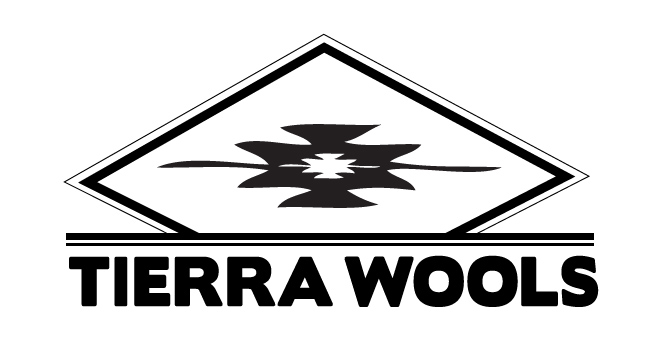
THE LOOMS
See tradition in action in our weaving workshop filled with locally hand-made Rio Grande Style walking looms.
An Ancient Design
At Tierra Wools, we create our weavings and teach our classes on the Rio Grande Style walking loom. The Rio Grande loom is a counter-balance floor loom whose ancestors were brought to the the North American continent from Spain in the 1500s. Over the centuries, the original European loom design was refashioned and replicated in homes throughout Mexico and what is now the Southwestern United States. The quality of construction ranged from very fine to very crude. Resourceful craftspeople often fashioned the looms using whatever materials were on hand: heavy rough-hewn beams, sinewy willow branches from the banks of waterways, homemade pulleys and cranks, and hand-carved gears.
These Colonial-era looms can be found today in museums and historic sites around New Mexico, and a few also remain in the homes of weaving families in the northern part of the state. The looms used at Tierra Wools are modeled after this ancient design. And, like each handmade loom from the Colonial era onward, each of the Tierra Wools looms has its own story…
Colonial-Era Rio Grande Floor Loom at the Albuquerque Museum
Colonial-Era Rio Grande Floor Loom at the Albuquerque Museum
Putting the Pieces Together
The Tierra Wools Building in the early days
As the idea for Tierra Wools began to pick up steam in the early 1980’s, the aspiring weavers worked hard to put all the necessary pieces in place to launch their venture. A local wool source was ready and waiting in the flocks of sheep raised in the area. A building was secured (the old T.D. Burns Mercantile building in Los Ojos, which housed Tierra Wools for 36 years). Sources of weaving knowledge and instruction came on board (most notably Rachel Brown of Taos, as well as a few local weavers with ancestral knowledge). Finally, the group of enthusiastic local weavers were ready to learn their craft and get to work. There was just one thing missing: the looms.
At that time, there were only a few people in the area who had looms in their homes. They were usually either looms that had been passed down in their families, or looms that they themselves had built. In order to employ all the weavers, Tierra Wools would need more than just a couple of looms – they would need a whole fleet. The group employed local craftsman Cruz Aguilar to fashion a set of pine looms for use in the workshop, and the weavers eagerly got to work.
Tierra Wools weavers warp a loom in the 1980s
While these first looms were well-constructed, after a period of time the weavers found that the soft wood they were made of was not conducive to the looms’ high level of use. Tierra Wools was a full-time production environment where weavers used the looms five days a week, 6-8 hours a day. New looms soon became necessary. The group set out to find something that could withstand very heavy daily use for many years to come.
Luckily for Tierra Wools, Rachel Brown’s Taos company Weaving Southwest was in the business of building looms. A deal was made, and a few of Rachel’s looms were purchased and moved into the Tierra Wools workshop. Meanwhile, in a quest for something even heavier and more durable, a connection was made with craftsman Hans Leitner. Hans, originally from Austria, was married to a weaver named María from Chimayó, New Mexico – another ancestral weaving community several miles to the south.
A Loom to Fit the Weaver
Weaving on a Hans Leitner Rio Grande Style loom
Hans visited Tierra Wools and stayed for a period of time observing the workshop, asking questions, and taking measurements. His goal was to design an exceedingly sturdy and long-lasting floor loom on which the Tierra Wools weavers – mainly women at the time – could work comfortably and produce large, heavy-duty textiles for decades to come. After learning all he could about what the weavers needed, Hans designed and built five large hardwood Rio Grande walking looms for Tierra Wools. These looms, which are still in use today, are characterized by sleek, thick beams with smooth rounded corners, a huge square back warp beam designed to hold dozens of yards of warp at once, and heavy “x” braces built into the loom to maintain its structural integrity over time and provide the sturdiness necessary for weaving on a high-tension warp. Heavy and simple, smooth and sophisticated, Hans’ looms have been a fixture – and a weaver favorite – since their arrival in the workshop over 30 years ago.
Weaving on a Hans Leitner Rio Grande Style loom
In the years since Tierra Wools began, several looms – all handmade – have come through the workshop, each from a different place and with a different history. Sophia DeYapp, the longtime Production Manager of Tierra Wools, coordinated loom acquisitions throughout the years, repaired and maintained the looms, and helped weavers who opted to work at home get looms constructed to their specifications. Next time you visit Tierra Wools, check out the weaving area and see if you can identify the Hans Leitner looms and the one remaining Rachel Brown loom. They – as well as all the other looms, and the work produced on them – are truly one-of-a-kind.
Who built our looms?
Cruz Aguilar
Hans Leitner
Rachel Brown
Dave Baber
Lawrence Dilka
Lawrence Carrillo
Maker Unknown - Originated in Canjilón, NM
Loom-Building Class at local Community College
And more…
Warping a Hans Leitner loom
Warping a Hans Leitner loom
L-R: Aubrey, Sophia and Mary weave on the Tierra Wools looms
L-R: Molly, Toni, and a weaving student on the Tierra Wools looms

